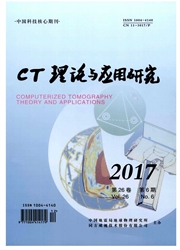

 中文摘要:
中文摘要:
目的:探讨在100kV管电压条件下应用碘克沙醇低碘浓度(270 mgI/mL)对比剂,结合大螺距前瞻性心电门控螺旋扫描(FLASH spiral)模式和正弦波迭代重建技术(SAFIRE)行冠状动脉CT成像(CCTA)的可行性.方法:收集接受CCTA检查且心率≤ 70次/min的患者60例,随机分为A、B两组.A组患者采用FLASH spiral扫描模式,扫描管电压100 kV,碘对比剂浓度为270 mgI/mL,应用迭代重建技术(SAFIRE),重建卷积核I26f;B组患者采用前瞻性心电门控序列扫描模式,扫描管电压为120 kV,碘对比剂浓度为370 mgI/mL,采用滤波反投影重建(FBP),重建卷积核B26f,比较两组患者CCTA图像质量与有效射线剂量的差异性.结果:①两组患者年龄、心率和BMI比较,差异无统计学意义(P>0.05).②图像质量:两组图像质量主观评价比较,差异无统计学意义(P>0.05).两组图像质量客观评价比较,A、B两组在左冠状动脉主干的SD和SNR数值差异有统计学意义外(P<0.05),其他指标差异均无统计学意义(P>0.05).③辐射剂量:A组平均有效射线剂量为(0.94±0.05)mSv,B组(4.31±1.21)mSv,两组的差异有统计学意义(P<0.05).A组有效剂量较B组大幅减低,降幅约达78.2%.结论:100kV管电压条件下应用碘克沙醇低碘浓度(270mgI/mL)对比剂,结合FLASH扫描模式和SAFIRE行CCTA检查,图像质量可以满足临床诊断需要,与一般前瞻性心电门控序列扫描相比,有效剂量降低约78.2%.
 英文摘要:
英文摘要:
Objective: To evaluate the potential of acquiring the diagnostic images of coronary CT angiography with prospective ECG-triggered high pitch flash spiral acquisition in 100 kV tube voltage combined with iterative reconstruction and contrast of iodixanol (270 mgI/mL). Methods: The 60 patients were divided into A and B two groups randomly, whose heart rate 〈 70/min. In the A group, their coronary CT angiography images were collected with prospective ECG-triggered high pitch flash spiral mode in 100 kV tube voltage combined with iterative reconstruction (convolution kernel B26f) and contrast of iodixanol (270 mgI/mL). In the B group, their coronary CT angiography images were collected with prospective ECG-triggered sequence mode in 120 kV tube voltage combined with filtered back projection (convolution kernel B26f) and contrast of iopromide (370 mgI/mL). The image quality and effective radiation dose of two groups were assessed. Results: (1) There were no significant differences in age, heart rate and BMI between the two groups. (2) Image qualities: There were no significant differences in the subjective image quality evaluation between the two groups.In objective image quality assessment, in addition to the left coronary artery of SD and SNR numerical difference was statistically significant, no statistically significant difference were observed in the other indicators. (3) Radiation dose: The average effective radiation dose was (0.94± 0.05)mSv in group A and (4.31± 1.21) mSv in group B respectively. The differences between the two groups have statistical significance. In effective dose group A decreased sharply than group B by about 78.2%. Conclusions: In coronary CT angiography with prospective ECG-triggered high pitch flash spiral acquisition in 100kV tube voltage combined with iterative reconstruction and contrast of iodixanol (270 mgI/mL) which image quality can meet the demand of clinical diagnosis, it compared with prospective ECG-triggered sequenc
 同期刊论文项目
同期刊论文项目
 同项目期刊论文
同项目期刊论文
 期刊信息
期刊信息
